Related Research Articles

Banacek is an American detective TV series starring George Peppard that aired on the NBC network from 1972 to 1974. The series was part of the rotating NBC Wednesday Mystery Movie anthology. It alternated in its time slot with several other shows, but was the only one of them to last beyond its first season.
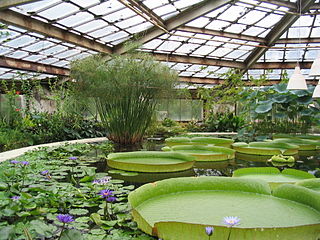
A greenhouse is a special structure that is designed to regulate the temperature and humidity of the environment inside. There are different types of greenhouses, but they all have large areas covered with transparent materials that capture sunlight and heat. The most common materials used in modern greenhouses for walls and roofs are rigid plastic made of polycarbonate, plastic film made of polyethylene, or glass panes. When the inside of a greenhouse is exposed to sunlight, the temperature increases, providing a sheltered environment for plants to grow even in cold weather.

Bakersfield is a city in and the county seat of Kern County, California, United States. The city covers about 151 sq mi (390 km2) near the southern end of the San Joaquin Valley, which is located in the Central Valley region.
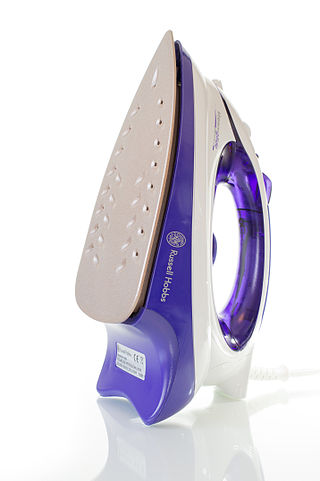
A clothes iron is a small appliance that, when heated, is used to press clothes to remove wrinkles and unwanted creases. Domestic irons generally range in operating temperature from between 121 °C (250 °F) to 182 °C (360 °F). It is named for the metal (iron) of which the device was historically made, and the use of it is generally called ironing, the final step in the process of laundering clothes.

Hearst Castle, known formally as La Cuesta Encantada, is a historic estate in San Simeon, located on the Central Coast of California. Conceived by William Randolph Hearst, the publishing tycoon, and his architect Julia Morgan, the castle was built between 1919 and 1947. Today, Hearst Castle is a museum open to the public as a California State Park and registered as a National Historic Landmark and California Historical Landmark.

Hardtack is a type of dense biscuit or cracker made from flour, water, and sometimes salt. Hardtack is inexpensive and long-lasting. It is used for sustenance in the absence of perishable foods, commonly during long sea voyages, land migrations, and military campaigns. Along with salt pork and corned beef, hardtack was a standard ration for many militaries and navies from the 17th to the early 20th centuries.

A pantry is a room or cupboard where beverages, food, (sometimes) dishes, household cleaning products, linens or provisions are stored within a home or office. Food and beverage pantries serve in an ancillary capacity to the kitchen.
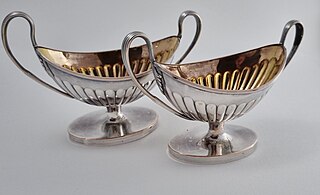
Old Sheffield Plate is the name generally given to the material developed by Thomas Boulsover in the 1740s, a fusion of copper and silver which could be made into a range of items normally made in solid silver. The material rapidly gained popularity as a substitute for solid silver, as it was much cheaper to produce. Any object made in silver could in effect be made in Old Sheffield Plate, although objects subject to heavy wear such as spoons and forks were not so satisfactory in plate.

Biscuit tins are utilitarian or decorative containers used to package and sell biscuits and some confectionery. Invented by Huntley & Palmers in 1831, they are commonly found in households in Great Britain, Ireland, and Commonwealth countries, but also in continental Europe and French Canada. Popularity in the United States and English Canada spread later in the 20th century. Over 60% of UK households own a biscuit tin.

California bungalow is an alternative name for the American Craftsman style of residential architecture, when it was applied to small-to-medium-sized homes rather than the large "ultimate bungalow" houses of designers like Greene and Greene. California bungalows became popular in suburban neighborhoods across the United States, and to varying extents elsewhere, from around 1910 to 1939.

Marlinspike Hall is Captain Haddock's country house and family estate in The Adventures of Tintin, the comics series by Belgian cartoonist Hergé.

A sash window or hung sash window is made of one or more movable panels, or "sashes". The individual sashes are traditionally paned windows, but can now contain an individual sheet of glass.

The Willow pattern is a distinctive and elaborate chinoiserie pattern used on ceramic tableware. It became popular at the end of the 18th century in England when, in its standard form, it was developed by English ceramic artists combining and adapting motifs inspired by fashionable hand-painted blue-and-white wares imported from Qing dynasty China. Its creation occurred at a time when mass-production of decorative tableware, at Stoke-on-Trent and elsewhere, was already making use of engraved and printed glaze transfers, rather than hand-painting, for the application of ornament to standardized vessels.

St Paul's Tower is a skyscraper located on Arundel Gate in Sheffield, South Yorkshire, England. Construction commenced in May 2006 and the building was topped out in August 2010, surpassing Sheffield University's Arts Tower as the tallest building in Sheffield at 101 metres (331 ft) tall. The city's first skyscraper, it was constructed as the centrepiece of the St Paul's Place project as part of the Heart of the City redevelopment of Sheffield city centre.

Victorian majolica properly refers to two types of majolica made in the second half of the 19th century in Europe and America.
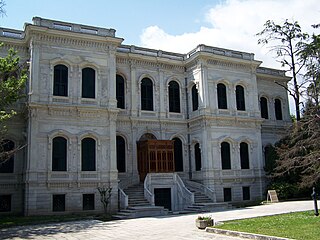
Yıldız Palace is a vast complex of former imperial Ottoman pavilions and villas in Beşiktaş, Istanbul, Turkey, built in the 19th and early 20th centuries. It was used as a residence by the sultan and his court in the late 19th century.

A fish slice is a kitchen utensil with a wide, flat blade with holes in it, used for lifting and turning food while cooking. It may be called a slotted spatula or a turner or flipper. The utensil was originally designed as a serving piece rather than a cooking implement.
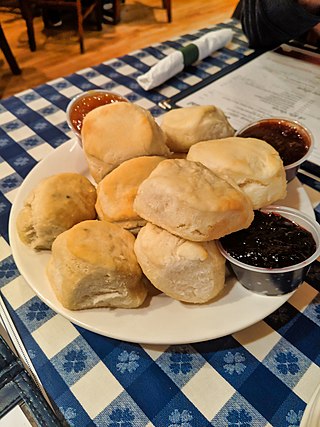
In the United States and Canada, a biscuit is a variety of baked bread with a firm, dry exterior and a soft, crumbly interior. It is made with baking powder as a leavening agent rather than yeast, and at times is called a baking powder biscuit to differentiate it from other types. Like other forms of bread, a biscuit is often served with butter or other condiments, flavored with other ingredients, or combined with other types of food to make sandwiches or other dishes.

A cellarette or cellaret is a small furniture cabinet, available in various sizes, shapes, and designs which is used to store bottles of alcoholic beverages such as wine or whiskey. They usually come with some type of security such as a lock to protect the contents. Such wooden containers for alcoholic beverages appeared in Europe as early as the fifteenth century. They first appeared in America in the early eighteenth century and were popular through the nineteenth century. They were usually made of a decorative wood and sometimes had special designs so as to conceal them from the casual observer. They were found in pubs, taverns, and homes of the wealthy.

"A Fireproof House for $5000" is an article and house design by Frank Lloyd Wright published in the Ladies' Home Journal in April 1907. It is Wright's third and final publication in the journal following "A Home in a Prairie Town" and "A Small House with 'Lots of Room in It'" from February and July 1901, respectively. The drawings for the house were also included in Wright's 1910 Wasmuth Portfolio (Plate XIV).
References
- ↑ "Biscuit Warmer". Bakersfield, California: The Bakersfield Californian. 6 April 1955. p. 20.
- ↑ Bolger, Louise Ade (1980). "House & garden". House & Garden. Vol. 152, no. 4. Internet Archive. New York, etc.: Conde Nast Publications. p. 24.
- 1 2 Seymour B. Wyler (1949). The Book Of Sheffield Plate.
- 1 2 Helliwell, Stephen (1996). Understanding antique silver plate. Internet Archive. Woodbridge, Suffolk : Antique Collectors' Club. p. 168. ISBN 978-1-85149-247-3.
- ↑ Newman, Harold (2000). An Illustrated Dictionary of Silverware. London: Thames & Hudson. ISBN 9780500281963.
- ↑ MacPherson, Charles (Butler) (2013). The butler speaks : a guide to stylish entertaining, etiquette, and the art of good housekeeping. Internet Archive. [Toronto, Ont.] : Appetite by Random House. ISBN 978-0-449-01591-9.